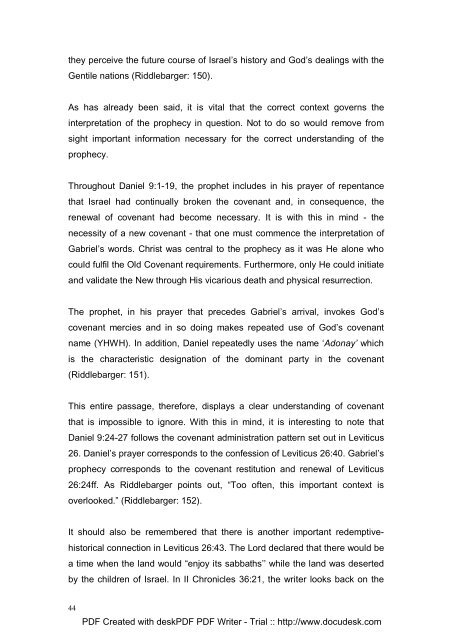A critical analysis of premillennial dispensationalism's interpretation ...
A critical analysis of premillennial dispensationalism's interpretation ...
A critical analysis of premillennial dispensationalism's interpretation ...
You also want an ePaper? Increase the reach of your titles
YUMPU automatically turns print PDFs into web optimized ePapers that Google loves.
they perceive the future course <strong>of</strong> Israel’s history and God’s dealings with the<br />
Gentile nations (Riddlebarger: 150).<br />
As has already been said, it is vital that the correct context governs the<br />
<strong>interpretation</strong> <strong>of</strong> the prophecy in question. Not to do so would remove from<br />
sight important information necessary for the correct understanding <strong>of</strong> the<br />
prophecy.<br />
Throughout Daniel 9:1-19, the prophet includes in his prayer <strong>of</strong> repentance<br />
that Israel had continually broken the covenant and, in consequence, the<br />
renewal <strong>of</strong> covenant had become necessary. It is with this in mind - the<br />
necessity <strong>of</strong> a new covenant - that one must commence the <strong>interpretation</strong> <strong>of</strong><br />
Gabriel’s words. Christ was central to the prophecy as it was He alone who<br />
could fulfil the Old Covenant requirements. Furthermore, only He could initiate<br />
and validate the New through His vicarious death and physical resurrection.<br />
The prophet, in his prayer that precedes Gabriel’s arrival, invokes God’s<br />
covenant mercies and in so doing makes repeated use <strong>of</strong> God’s covenant<br />
name (YHWH). In addition, Daniel repeatedly uses the name ‘Adonay’ which<br />
is the characteristic designation <strong>of</strong> the dominant party in the covenant<br />
(Riddlebarger: 151).<br />
This entire passage, therefore, displays a clear understanding <strong>of</strong> covenant<br />
that is impossible to ignore. With this in mind, it is interesting to note that<br />
Daniel 9:24-27 follows the covenant administration pattern set out in Leviticus<br />
26. Daniel’s prayer corresponds to the confession <strong>of</strong> Leviticus 26:40. Gabriel’s<br />
prophecy corresponds to the covenant restitution and renewal <strong>of</strong> Leviticus<br />
26:24ff. As Riddlebarger points out, “Too <strong>of</strong>ten, this important context is<br />
overlooked.” (Riddlebarger: 152).<br />
It should also be remembered that there is another important redemptivehistorical<br />
connection in Leviticus 26:43. The Lord declared that there would be<br />
a time when the land would “enjoy its sabbaths’’ while the land was deserted<br />
by the children <strong>of</strong> Israel. In II Chronicles 36:21, the writer looks back on the<br />
44<br />
PDF Created with deskPDF PDF Writer - Trial :: http://www.docudesk.com

















